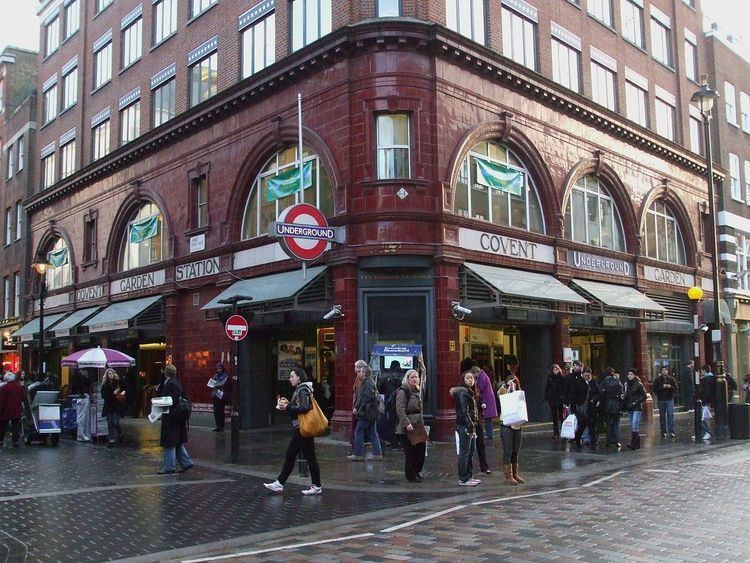2012 21.29 million Address London, United Kingdom | Local authority Fare zone 1 2013 21.17 million Number of platforms 2 London borough City of Westminster | |
 | ||
Similar London Underground, Leicester Square tube station, Holborn tube station, Piccadilly Circus tube station, Russell Square tube station | ||
Historic london underground stations covent garden tube station
Covent Garden is a London Underground station in Covent Garden. It is on the Piccadilly line between Leicester Square and Holborn stations and is in Travelcard Zone 1. The station is at the corner of Long Acre and James Street and is a Grade II listed building.
Contents
- Historic london underground stations covent garden tube station
- Timelapse london s covent garden tube station stairs
- History
- Design
- Platform level tiling
- Access
- Proximity to Leicester Square
- Services and connections
- Future proposals
- Folklore
- References
Timelapse london s covent garden tube station stairs
History
The station was planned by the Great Northern and Strand Railway (GN&SR), which had received parliamentary approval for a route from Wood Green station (now Alexandra Palace) to Strand in 1899. After the GN&SR was taken over by the Brompton and Piccadilly Circus Railway (B&PCR) in September 1901, the two companies came under the control of Charles Yerkes' Metropolitan District Electric Traction Company before being transferred to his new holding company, the Underground Electric Railways Company of London (UERL) in June 1902. To connect the two companies' planned routes, the UERL obtained permission for new tunnels between Piccadilly Circus and Holborn. The companies were formally merged as the Great Northern, Piccadilly and Brompton Railway following parliamentary approval in November 1902. The station was opened by the Great Northern, Piccadilly and Brompton Railway on 11 April 1907, four months after services on the rest of the line began operating on 15 December 1906.
In 1929, Covent Garden was one of the stations suggested for closure in connection with the extension of the Piccadilly line: the elimination of less-busy stations in the central area would improve both reliability and journey times for long-distance commuters but this did not happen.
Design
Like the rest of the original GNP&BR stations, the street level station building and platform tiling was designed by Leslie Green. The station building is a classic red 'Oxblood' building which has two elevations fronting onto the end of James Street and Long Acre. The platform wall was tiled with two shades of yellow and white tiling which formed geometric shapes along with three blank spaces to incorporate the station name. As part of Transport for London's investment programme, the ageing tiling dating back from the station's opening was replaced in 2010 in a like-for-like basis, retaining the look and feel of the platforms.
Platform level tiling
The stations along the central part of the Piccadilly line, as well as some sections of the Northern line, were financed by Charles Yerkes, and are famous for the Leslie Green designed red station buildings and distinctive platform tiling. Each station had its own unique tile pattern and colours.
Access
Covent Garden station is one of the few stations in Central London for which platform access is only by lift or stairs and often becomes congested because of the Covent Garden area's popularity with tourists. To control congestion on Saturday afternoons, when the surrounding shopping areas are at their busiest, the station was previously exit-only to avoid the risk of dangerous overcrowding of the platforms, but following replacement of the lifts, this restriction was lifted. There are four lifts that give access to street level, although a final flight of stairs from the lifts to the platforms means that the station is wheelchair-inaccessible. Alternatively, there is an emergency spiral staircase of 193 steps (the equivalent to a 15-storey building).
Proximity to Leicester Square
The journey between Leicester Square station and Covent Garden takes only about 20 seconds, and measures only 260 metres (0.16 mi), the shortest distance between two adjacent stations on the Underground network. The stations are so close that a pedestrian standing halfway between them on Long Acre can see both tube stations by turning around 180°. The proximity means that London Underground's standard £4.80 single cash fare for the journey between these two stations equates to £29.81 a mile, making the fare for this particular journey more expensive per mile than the Venice Simplon Orient Express. Posters at the station give details of the alternative methods of getting to and from Covent Garden using surrounding stations.
Services and connections
Train frequencies vary throughout the day, but generally operate every 3-7 minutes between 06:03 and 00:31 in both directions.
No buses directly serve the station, however London Buses route RV1 stops around a 5 minute walk away.
Future proposals
Transport for London has made a commitment to ease the congestion at the station, which may involve the creation of a new exit further north along Long Acre (i.e. away from Covent Garden Piazza and nearer the eclectic shopping area that surrounds Neal's Yard), and the provision of escalator access.
Folklore
It is said that the ghost of actor William Terriss haunts the station. The last reported sighting of William Terriss was in 1972.
